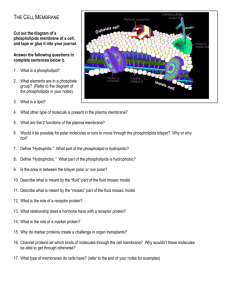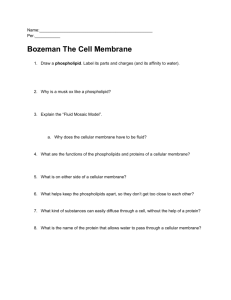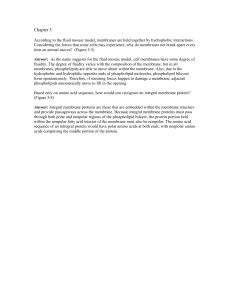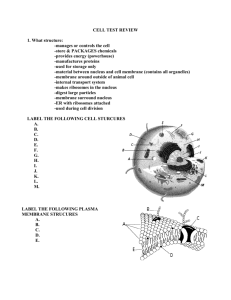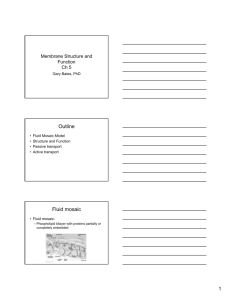FAUX QUIZ: CELL MEMBRANE
advertisement
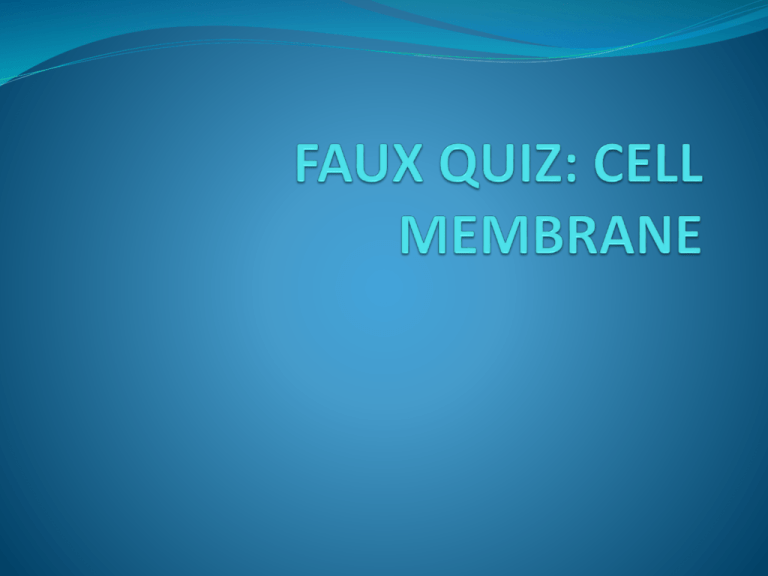
FUNCTIONS of the CELL MEMBRANE The cell membrane does all of the following EXCEPT: 1) Identifies cells 2) Contain genetic information to make new cells 3) Transports materials 4) Protects the cell TERMINOLOGY WHICH OF THESE TERMS MEAN TO LOVE WATER? 1) Amahydric 2) Hydrophobic 3) Hydroamarone 4) Hydrophillic WHICH ONE OF THESE TERMS DESCRIBES OF THE CELL MEMBRANE: 1) Simple (made out of one thing) 2) Complex (made out of many things) I NEED A VOLUNTEER FOR THIS ONE… WHAT IS THIS? A LITTLE LESSON FROM THE LITTLE GUY… What term describes the membrane’s selectivity in determining what it allows to pass through? 1) Fully permeable 2) Semi-permeable 3) Not permeable WHAT LESSON CAN WE LEARN FROM THE CELL??? OK, NOW FOR THE HARDER ONES… Which part of the fluid mosaic model accounts for the FLUID (liquid-like) portion? 1) Proteins 2) Carbohydrates 3) Phospholipids 4) Nucleic Acids STRUCTURE… Which part of the fluid- mosaic model accounts for the solid-like “mosaic” portion? 1) Proteins 2) Carbohydrates 3) Phospholipids 4) Nucleic Acids Chemistry is everything…. What end (if any) of the phospholipid is polar? Which end (if any) is nonpolar? 1) Head- polar 2) Head- nonpolar 3) Head- polar 4) Head- nonpolar Tail- nonpolar Tail-polar Tail- polar Tail- nonpolar STRUCTURE/FUNCTION THEME rears its Head again….ba dum cha How is the structure (polarity) of the phospholipid Head related to the function in water detection. TRANSLATION: IS THE PHOSPHOLIPID HEAD POLAR OR NOT? DOES IT ATTRACT WATER OR NOT? Topic: Structure/function of cell membrane relationship RESEARCH DO NOW: 1) What are the solid portions of the fluid mosaic model? (mosaic of what???) http://www.pbslearningmedia.org/asset/tdc02_int_membraneweb/ http://www.phschool.com/science/biology_place/biocoach/biomembrane1/structure.html 2) What are the roles of each molecule type in the structure of the cell membrane? A. Cholesterol B. Transport/Carrier protein C. Receptor protein D. Channel protein E. Cell recognition http://www.biologycorner.com/APbiology/cellular/notes_cell_membrane.html 3. What kinds of substances naturally (without energy) can pass? Which cannot? 4. How does the cell compensate for the substances that cannot pass through? http://www.phschool.com/science/biology_place/biocoach/biomembrane1/structure.html ACTIVITY: START (if time permits) BUILD A MEMBRANE ACTIVITY- in pairs (hands on) CELL MEMBRANE (electronically on) http://learn.genetics.utah.edu/content/cells/insideacell/ Hmwk: Complete lab write up for tomorrow
